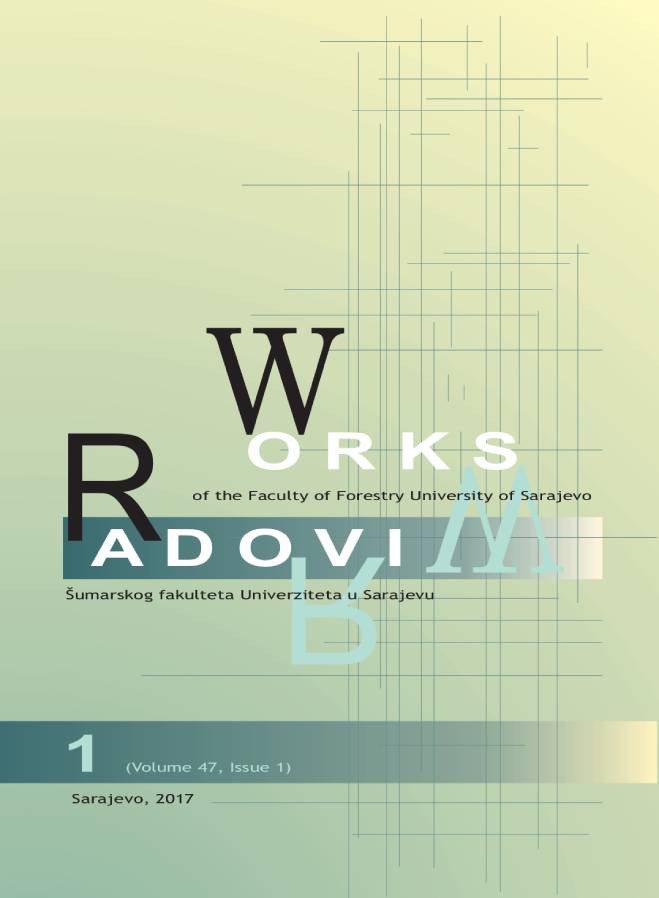DETERMINATION OF PHENOLIC CONTENT AND ANTIOXIDANT ACTIVITY OF ROSA CANINA L. FRUITS IN DIFFERENT EXTRACTION SYSTEMS
DOI:
https://doi.org/10.54652/rsf.2017.v47.i1.66Keywords:
Rosa canina L., fruits, phenols, antioxidant activityAbstract
UDK: 582.711.71:547.56
Phenolic content and antioxidant activity of Rosa canina fruit extracts obtained with five different extraction systems were investigated. Extractions were done with water, and aqueous 50% methanol, 50% ethanol, 80% methanol and 80% ethanol. Antioxidant activity was investigated with DPPH, ABTS and FRAP methods using Trolox as a standard. The highest level of phenols (78.83 mg GAE/g), phenolic acids (11.21 mg CAE/g), and proanthocyanidins (29.12 mg CE/g) were found for 50% methanol extract. The highest flavonoid content (1.163 mg RE/g and 0.675 mg QE/g) was determined for 50% ethanol extracts and antocyanin content (0.139 mg CGE/g) for 80% methanol extract. The lowest level of phenols (35.89 mg GAE/g), phenolic acids (4.55 mg CAE/g) and proanthocyanidins (11.93 mg CE/g) had 80% ethanol extract. Flavonoid content (0.341 mg RE/g and 0.214 mg QE/g) was the lowest in water extract and anthocyanidin content (11.93 mg CE/g) in 50% ethanol extract. Antioxidant activity for DPPH was in a range 255.62-407.82 µmol TE/g, for ABTS 312.06-616.10 µmol TE/g and for FRAP 349.33-690.37 µmol TE/g with lowest values for 80% ethanol extract and highest values for 50% methanol extract. Phenols and proanthocyanidins showed high positive correlation with antioxidant activity for DPPH (r2 =0.927-0.9621), ABTS (r2 =0.980-0.9935) and FRAP (r2 =0.9352-0.9633). No correlation was observed for flavonoid and anthocyanidin content with antioxidant activity.
References
ADAMCZAK, A., BUCHWALD, W., ZIELINSKI, J, MIELCAREK, S. 2012: Flavonoid and organic acid content in rose hips (Rosa L., sect.Caninae DC.EM.Christ.). Acta Biologica Cracoviensla. Series Botanica, 54(1):1–8.
BARROS, L., CARVALHO, A.M., MORAIS, J.S., FERREIRA, I.C.F.R. 2010: Strawberry-tree, blackthorn and rose fruits: Detailed characterisation in nutrients and phytochemicals with antioxidant properties. Food Chemistry, 120:247–254.
BENZIE, I.F. AND STRAIN, J.J. 1999: The ferric reducing ability of plasma (FRAP) as a measure of "antioxidant power": the FRAP assay. Analytical Biochemistry, 239(1): 70-6.
BLUMENTHAL, M. 1998: The complete German Commision E Monographs. American Botanical Council: Austin, TX, USA, 368-369.
BOOTS, W.A., HAENEN, G.R., BAST, A. 2008: Health effects of quercetin: From antioxidant to nutraceutical. European Journal of Pharmacology, 585: 325–337.
BRAND-WILLIAMS, W., CUVELIER, M.E., BERSET, C. 1995: Use of free radical method to evaluate antioxidant activity. Lebensm Wiss Technology, 28:25-30.
CHRUBASIK, C., ROUFOGALIS, B.D., MÜLLER-LADNER, U., CHRUBASIK, S. A. 2008: systematic review on the Rosa canina effect and efficacy profiles. Phytotherapy Research, 22: 725–733.
CORUH, S., ERCISLI, S. 2010: Interactions between galling insects and plant total phenolic contents in Rosa canina L. genotypes. Scientific Research and Essays, 5(14):1935–1937.
CUNJA, V., MIKULIC-PETKOVSEK, M., ZUPAN, A., STAMPAR, F., SCHMITZER, V. 2015: Frost decreases content of sugars, ascorbic acids and some quercetin glycosides but stimulates selected carotenes in Rosa canina hips. Journal of Plant Physiology, 178: 57
DEMIR, F., OZCAN, M. 2001: Chemical and technological properties of rose (Rosa canina L.) fruits grown wild in Turkey. Journal of Food Engineering, 47: 333–336.
DEMIR, N., YILDIZ, O., ALPASLAN, M., HAYALOGLU, A.A. 2014: Evaluation of volatiles, phenolic compounds and antioxidant activities of rose hip (Rosa L.) fruits in Turkey LWT - Food Science and Technology, 57: 128
ERCISLI, S. AND GULERYUZ, M. 2005: Rose hip utilization in Turkey. Acta Horticulturae, 490: 77–83.
ERCISLI, S. 2007: Chemical composition of fruits in some rose (Rosa spp.) species. Food Chemistry, 104: 1379–1384.
ERSOY, N., BAGCI, Y., ZENGINBAL, H., OZEN, M.S., ELIDEMIR, A.Y. 2015: Antioxidant properties of Rosehip fruit types (Rosa canina sp.) selected from Bolu-Turkey. International Journal of Science and Knowledge, 4(1): 51-59.
FATTAHI, S., JAMEI, R., HOSSEINI SARGHEIN, S. 2012: Antioxidant and antiradical activity of Rosa canina and Rosa pimpinellifolia fruits from West Azerbaijan. Iranian Journal of Plant Physiology, 2(4):523–529.
GAO, X., BJORK, L., TRAJKOVSKI, V., UGGLA, M. 2000: Evaluation of antioxidant activities of rose hip ethanol extracts in different test systems. Journal of the Science of Food and Agriculture, 80: 2021–2027.
GAWLIC-DZIKI, U. 2012: Dietary spices as natural effectors of lipoxygenase, xanthine oxidase, peroxidase and antioxidant agents. LTW-Food Science and Technology, 47: 138-146.
GHAZGHAZI, H., MIGUEL, M.G., HASNAOUI, B., SEBEI, H., KSONTINI, M., FIGUEIREDO, A.C., PEDRO, L.G., BARROSO, J.G. 2010: Phenols, essential oils and carotenoids of Rosa canina from Tunisia and their antioxidant activities. African Journal of Biotechnology, 9(18): 2709-2716.
GUERRERO, C.J., CIAMPI, P.L., CASTILLA, A.C., MEDEL, S.F., SCHALCHLI, H.S., HORMAZABAL, E.U., BENSCH, E.T., ALBERDI, M.L. 2010: Antioxidant capacity, anthocyanins, and total phenols of wild and cultivated berries in Chile. Chilean Journal of Agricultural Research, 70 (4): 540
HAGERMAN, A.E. 2002: The Tannin Handbook. Miami University Oxford.


















